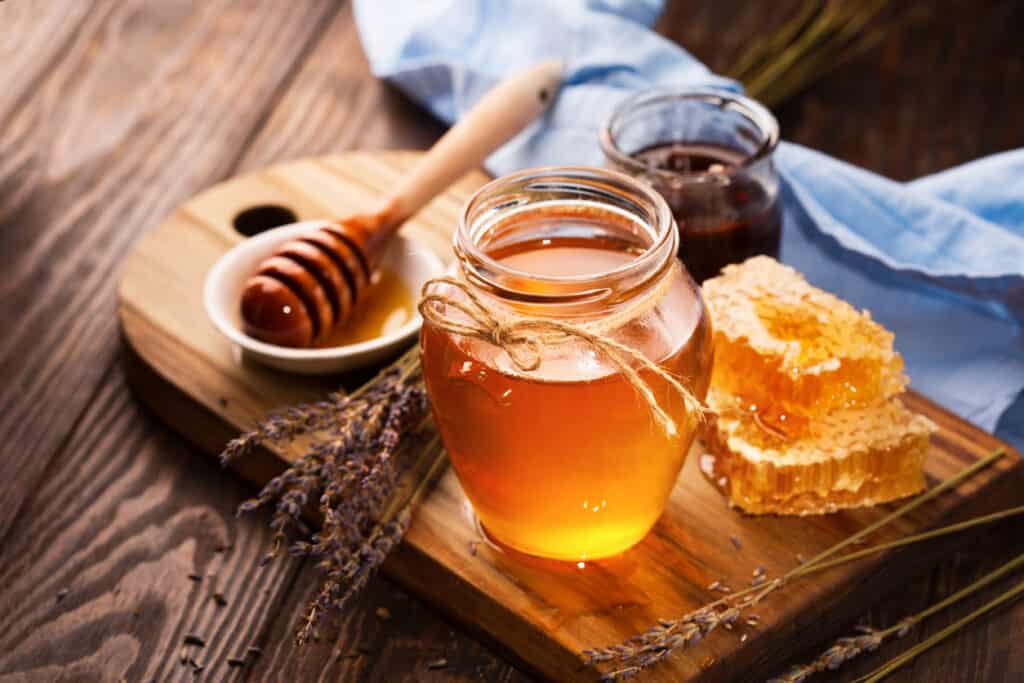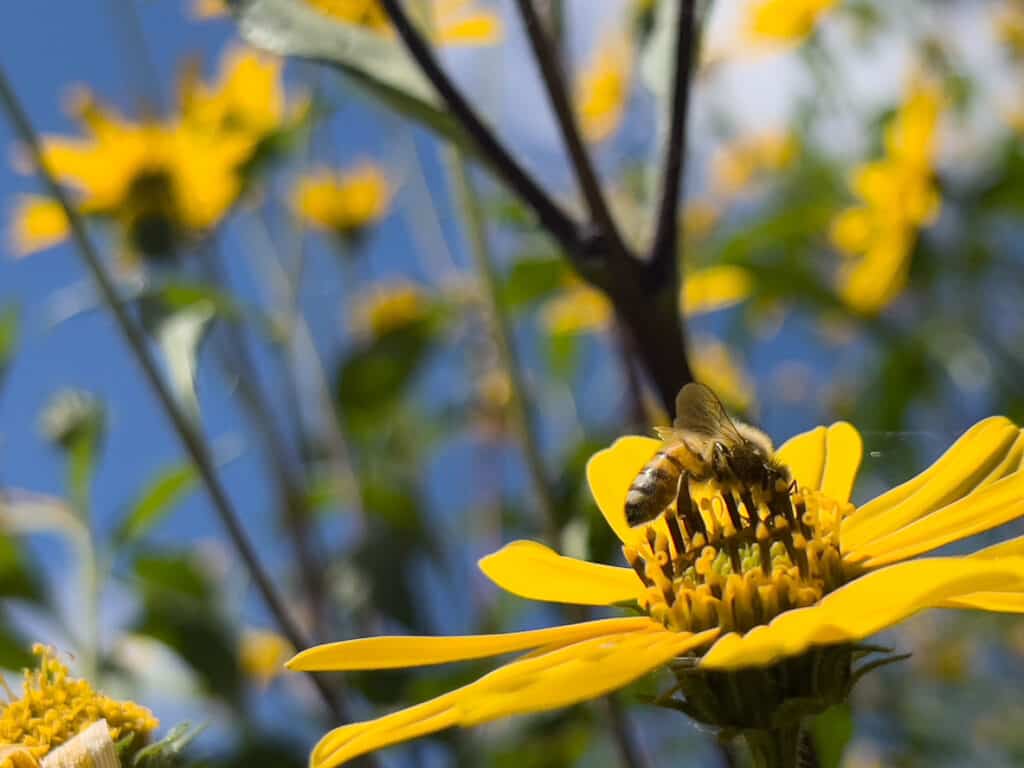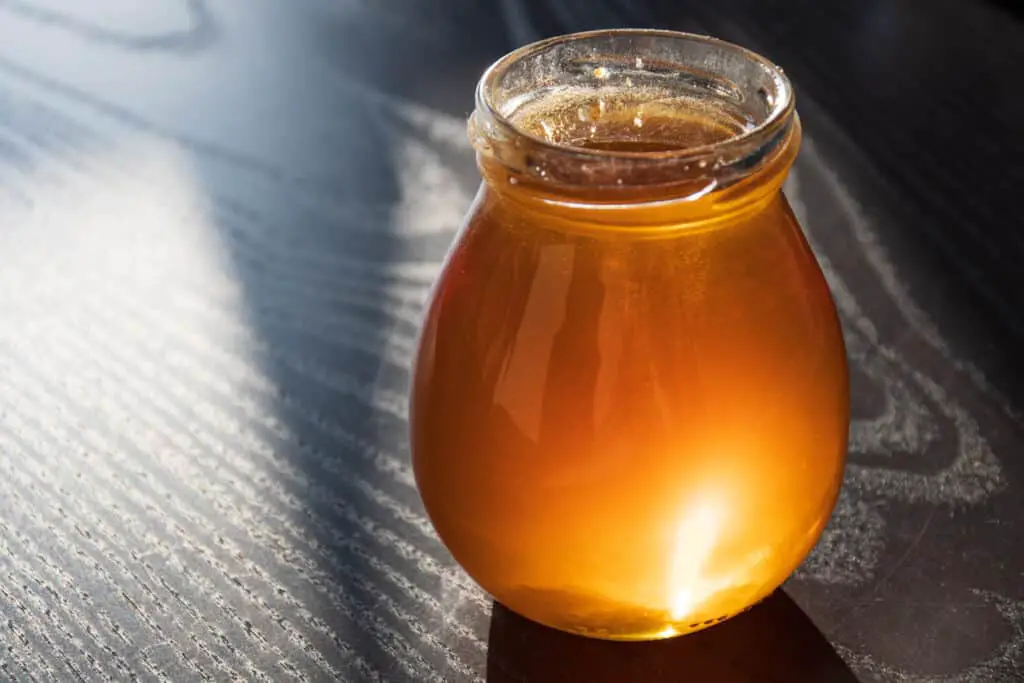Tupelo swirls with legendary tales, 1970s folk-rock, and theatre; even the famous Elvis Presley comes from a small town in Mississippi called Tupelo. But have you ever come across the distinct, premium-priced Tupelo honey found in the dark Southern swamps? Your perspective of honey will be changed forever!
Tupelo honey is rare, mono-floral honey gathered from the White Tupelo tree. This honey is light amber with a greenish hue and prized for its buttery sweetness. It also has high fructose to glucose ratio, so it does not crystallize and deems safe for diabetics to use as a sweetener.
Tupelo honey is one of the rarest kinds of honey in the world. Find out why honey connoisseurs chase after this expensive sweetener and why only a small cadre of beekeepers fiercely pursue this lucrative prize.
What Is Tupelo Honey?

Tupelo honey falls under the top 10 rare kinds of honey in the world.
This delicacy was kept under the radar for centuries -eaten only in areas of Florida and Georgia -until the rockstar Van Morrison released his debut album Tupelo honey. Ever since, honey enthusiasts have sought after the scarce and exorbitant sweetener prized for its buttery sweetness and spicy-floral aroma.
Tupelo honey boasts an unmatchable color, texture, and taste.
When beekeepers harvest pure Tupelo honey, it results in light amber honey with a greenish cast. In addition, it boasts full-bodied, buttery flavors laced with hints of cinnamon and fresh, fragrant flowers.
Aside from its scarcity and distinct flavor profile, tupelo honey has one of the highest fructose-to-glucose ratios -only falling short of locust or Acacia honey. This exceptional ratio makes it stand out from other honey types.
Today, honey advocates come from all over, attempting to get their hands on this precious honey. And as with any demand surpassing supply scenario, Tupelo honey’s price has skyrocketed, reaching all-time highs.
Where Does Tupelo Honey Come From?
Tupelo honey is limited to the southeastern regions of the United States.
While there are 9 tupelo tree species belonging to the sour gum family, the White Gum Tupelo tree is responsible for the highly-prized liquid gold.
The White Tupelo tree is also known as the Ogeechee Lime tree. It is mainly limited to regions of the Southern Cypress swamp, namely the Okeefenokee Wildlife Refuge situated on the Georgia-Florida line and the Apalachicola River basin in the crook of Florida.
While the Ogeechee Lime tree grows in other areas, the 100-mile Southern Cypress swamp is the only ecosystem supporting a multitude of White Tupelo tree stands. The seasonal flooding and moist soil conditions provide an ideal environment, ensuring a thriving White Tupelo Forest.
As a result of the limited trees, pure Tupelo honey is exceptionally scarce.
Brave beekeepers load their beehives on barges to float them in the lurking, alligator-infested swamp water for the tree’s limited two-to-three-week blooming period between April and May.
Why Is Tupelo Honey Rare?
Tupelo honey is rare because of the following factors:
- Limited produce
- Short harvest season (two to three weeks)
- Labor intensive and risky harvest
- Insecticides
Tupelo honey’s strict regional nature dictates its production to exist only in a tiny subculture.
As if the limited region isn’t enough, alligators inhabit the dark Southern swamps surrounding Tupelo trees, making it risky for beekeepers to set up their apiaries. There are fewer than 200 beekeepers that chase the Tupelo bloom due to its risky affair and minimum quantities.
Then, Tupelo trees bloom for a narrow window of three weeks that mother nature can reduce or destroy if temperamental. After that, the tiny blossoms are delicate, and severe rain spells or gusty winds can wipe out the whole lot!
The swamp weather has to be “just right” for the bees to produce the Southern Gold we all yearn to taste.
Because of the Tupelo trees’ brief flowering time, beekeepers need to be precise about getting their bees to the trees. So the beekeepers house their bees on remote floating docks that they can only access by boat.
Beekeepers also have to use special equipment to manage the bees continually during the harvest.
Lastly, the vast number of insecticides used for mosquito control reach the bees, killing them on the spot. The fewer bees we have, the slower they can gather nectar in the three-week window, and the less Tupelo honey beekeepers can harvest.
How Is Tupelo Honey Made?

Tupelo honey starts in the dark, murky Southern swamps, where the White Tupelo trees twist up out of the water.
Then, for two-to-three precious weeks between April and May, the White Tupelo trees boast clusters of pale white and green, fragile blossoms resembling tiny cheerleader pompoms.
The hard-working bees reside in the hives on elevated platforms along the banks or the barges floating in the water. They fan around the White-Tupelo-blossom-laden swamps as they get to work, harvesting the alluring nectar beneath the pollen-laden anthers from the delicate, inconspicuous Tupelo blossoms.
Once the bees return to their hive, they pass the sweet nectar between themselves, mixing it with their enzymes (invertase) to reduce the water content. In turn, invertase converts the nectar into simple sugars that the honeybees store inside the comb.
The fanning of the bees’ wings and the unique honeycomb design encourage evaporation, converting the Tupelo nectar into sweet honey capsulated with a protective waxy layer.
What Makes Tupelo Honey Special?
Most honey that we find in supermarkets is filled with a homogenized version. The syrupy liquid is derived from thousands of colonies and floral sources and distilled to supply a consistent sweetness, color, and texture.
Tupelo honey is a monofloral honey variety made almost entirely from one floral source -the White Tupelo blossom.
Tupelo honey tastes nothing like the mediocre syrup in bear-shaped bottles that we’ve grown accustomed to using. Instead, pure and raw Tupelo honey boasts an unmatchable sweetness, color, and viscosity.
Tupelo honey is chock full of unique, mouth-watering flavors. In addition, Tupelo takes on a unique characteristic if 100% pure -it does not crystallize due to the high fructose content.
Most honey varieties are prone to crystallize over time from their unstable sugar and water composition. Honey with high glucose and low fructose concentrations crystallizes more quickly than those with a high fructose content.
Beekeepers have to work extra hard to ensure the hives are strategically placed and at the perfect time. The bees might forage on other floral varieties if the beehives and empty supers are put out too early. On the other hand, if the beekeepers leave it for too long, the bees will move on to the next best nectar source.
For Tupelo honey to be considered monofloral honey, it is subject to pollen analysis to determine whether the honey contains sufficient Tupelo nectar levels. The pollen content needs to be over 51%; anything less would not make the cut.
Amazingly, you can find Tupelo honey containing 95% Tupelo pollen.
What Does Tupelo Honey Taste Like?
When you first take a lick of Tupelo honey, you’ll almost taste the rich culture and sweetness of the swamp. Tupelo honey is undoubtedly the heartbeat of the Southern Cypress swamp!
Pure Tupelo honey is soft, smooth, and lends a light buttery texture with a vanishing sweetness and no aftertaste.
Tupelo honey initially offers a cinnamon taste with a tinge of anise. Then, these flavors give way to whispers of tangerine rinds and light floral essence.
This honey variety has a similar texture to other varieties; however, it does not crystallize.
After breaking out into a large grin from your first taste, your only logical move is to lean in for a second scoop of heaven.
Is Tupelo Honey Dark Or Light?

Raw, pure Tupelo honey is generally light amber with a greenish cast when held up to the light.
The greenish tint is said to come from the Tupelo pollen traces present in the raw Tupelo honey.
Is Tupelo Honey Healthy?
Raw, unfiltered Tupelo honey might not be easy to come by. Still, it offers exceptionally high nutritional values as a bonus to its great taste.
Raw, unfiltered honey is one of the best and most reliable all-natural healers. These remedies date far back throughout time and cultures for their great medicinal purposes. For example, ancient Egyptians used raw honey for wound dressing, burn treatments, and the embalming process.
Here are the excellent health benefits of Tupelo honey:
Note: Tupelo honey’s benefits are solely based on raw honey. Filtering or processing honey will break down the beneficial enzymes and antioxidants from heat exposure. So, it won’t provide the same healing properties.
Tupelo Honey Is A Natural Source Of Sugar
Tupelo honey has an exceptionally high fructose content. Therefore, it’s the perfect source of natural and slow-releasing sugar.
The slow release ensures a prolonged energy release. This trait makes it ideal for athletes requiring a sustainable energy source and aiming to boost their performance.
The high fructose and low glucose content make Tupelo honey suitable for diabetes or individuals trying to control their blood sugar.
Tupelo Honey Is Safe For Diabetics
Fructose is a healthier sweetener than glucose, and it breaks down more quickly in the body.
The slow-releasing natural fructose sugar will significantly reduce “sugar crash” symptoms often associated with white sugar (sucrose). Therefore, Tupelo honey is an ideal alternative sweetener.
Thanks to Tupelo’s low sucrose content, doctors generally allow diabetic patients to enjoy this honey as an alternative sweetener.
Tupelo Honey Is An Excellent Antimicrobial Agent
Tupelo honey can help combat harmful bacteria.
Honey deems an excellent antimicrobial agent due to hydrogen peroxide concentrations produced naturally. During pollen synthesis, the bees deposit hydrogen peroxide, a natural antiseptic, into the honey.
Therefore, Tupelo honey can combat harmful bacterial or fungal infections, including salmonella and E. coli.
Tupelo Honey Supports Healthy Digestion
Tupelo honey is a powerful antibacterial and rich in gut-healthy enzymes. The combination of these two traits helps to support a healthy digestive system.
Tupelo honey serves as a prebiotic food that will nourish the good bacteria living in your intestines -crucial for digestion al overall health. In addition, the natural carbohydrates and enzymes in Tupelo honey help support a healthy microbiome that will keep your gut-friendly bacteria well-functioning.
Raw Tupelo honey can act as an ulcer and indigestion remedy. It is also occasionally used to treat digestive issues such as diarrhea.
Tupelo Honey Is Rich In Nutrients
Raw Tupelo honey contains an array of enzymes, amino acids, nutrients, vitamins, minerals, and other beneficial compounds.
Tupelo honey contains the following micronutrients:
- Vitamin C
- Calcium
- Iron
- magnesium
- Niacin
- Phosphorous
- Potassium
- Riboflavin
- Thiamine
- Zinc
All these micronutrients work together to keep your body healthy and strong.
Tupelo Honey Can Boost Your Immune System
Raw, unfiltered Tupelo honey contains traces of bee pollen and propolis.
Propolis
The resinous (glue-like) material is produced by honeybees mixing saliva and beeswax gathered from botanical sources.
Propolis contains over 300 compounds, with the majority consisting of polyphenols. These powerful antioxidants help support a well-balanced, effective immune system.
Bee Pollen
Bee pollen is the ball of field-gathered flower pollen, bee secretions, wax, and enzymes packed by worker honeybees. It primarily consists of simple sugars, protein, vitamins and minerals, and fatty acids.
Bee pollen is a superfood that strengthens the immune system, speeds up healing, and works as a powerful antioxidant.
Tupelo Honey Is Healthy For Skin
Tupelo honey is rich in antioxidants, including:
- Flavonoids
- Phenolic acids
- Vitamin C
The antioxidants help support your skin, keeping it radiant and healthy-looking. They also have unique regenerative properties that fight off toxins and free radicals.
One of the more significant Tupelo honey benefits includes its high Oxygen Radical Absorbance Capacity (ORAC) value. Therefore, Tupelo honey can help protect your skin from dangerous UV rays, a leading cause of premature aging, hyperpigmentation, dull skin, and skin cancer.
Apply Tupelo honey or products that contain Tupelo honey topically for glowing, youthful skin.
Tupelo Honey Has Anti-Inflammatory Properties
Tupelo honey contains powerful anti-inflammatory properties.
Raw honey can treat an infected wound, and it positively affects arthritis, gastric ulcers, lupus, and other inflammatory-related conditions.
Since inflammation and oxidative stress contribute to heart disease and certain cancers, Tupelo honey’s antioxidant properties will actively help prevent both conditions.
Tupelo Honey Can Treat Coughs And Sore Throats
Tupelo honey can help treat coughs and soothe sore throats -no, it isn’t just an old wives’ tale.
Add a teaspoon of Tupelo honey to your hot tea, or eat it straight from the spoon when you start feeling under the weather.
Can I Give Tupelo Honey To My Child?
Avoid giving Tupelo honey (including other raw honey varieties) to a child younger than a year old. Raw, unfiltered honey can cause Infant Botulism, a rare but severe illness caused when a baby ingests toxins from a specific bacterium.
Babies suffering from Infant Botulism can experience symptoms like:
- muscle weakness in the baby’s neck, arms, and legs
- a weak cry
- constipation
- lethargy
- slow breathing
- loss of head control
- weak facial muscles
- paralysis that spreads downward
- poor feeding
While Infant Botulism primarily affects babies up to six months, all children are at risk until a year old.
Children older than a year old have a more robust immune system, reducing the risk of harmful bacteria when eating raw, contaminated honey.
Can You Be Allergic To Tupelo Honey?
Tupelo honey is primarily safe for anyone over a year old. However, suppose you have allergies to other honey varieties or develop an allergic reaction toward the Tupelo pollen, fruit, or honey. In that case, it’s best to avoid consuming the honey.
Tupelo honey is risky for individuals with bee-related allergies, including products like beeswax, propolis, pollen, etc. These bee products can seep into the honey, causing your body to react exaggeratedly to the harmless products, hence the allergic reaction.
Your body might also be more sensitive to the bees’ enzyme secretions while making the honey. However, you’ll generally experience an allergic reaction to all honey varieties.
Is Tupelo Honey Expensive?
Pure Tupelo honey will cost you a pretty penny!
Tupelo honey is a gourmet and extremely scarce honey variety. In addition, the White Tupelo tree only blossoms for a short three weeks, offering a limited window of opportunity for bees to produce pure Tupelo honey.
However, its other traits also add to its premium price.
Tupelo honey boasts bright, incomparable, and mesmerizing flavors. But then, if pure, it will resist crystallization. And lastly, the risky harvest of balancing on rocky boats among swamps lurking with alligators definitely pushes up the price.
The combination of high demand and unpredictable annual supply means that Tupelo honey prices are sky-high compared to other varieties.
Due to pure Tupelo honey’s scarcity and expensiveness, many manufacturers sell fake Tupelo honey or products containing mere Tupelo honey traces. The adulterating and faking of Tupelo honey is a vast problem. So, buy this rare commodity from trusted suppliers.
Once you taste Tupelo honey, you’ll fall in love and understand the premium rate price tag -we believe it’s worth every penny!
Is Tupelo Honey The Sweetest Honey?
Tupelo honey is not the sweetest honey, but it comes in close.
The most common determinant of honey’s sweetness is the ratio of the various sugars, mainly fructose, glucose, sucrose, and maltose). Honey that contains high fructose levels is naturally the sweetest.
Based on a 2017 study, European locust honey has the sweetest score. However, tupelo honey comes in a close second.
Does Tupelo Honey Crystallize?
While most raw honey varieties crystallize over time, pure Tupelo honey does not crystallize.
Honey generally crystallizes from its unstable sugar and water composition. The glucose and fructose concentrations and ratios determine how easily honey crystallizes (without any intervention).
Honey varieties like clover and canola have high glucose and low fructose concentrations and are prone to crystallize more quickly. However, Tupelo honey has the opposite quality; it has an exceptional amount of fructose sugars, preventing it from crystallizing.
Fructose aids in preserving honey’s texture. Tupelo honey contains roughly 44% fructose and 33% glucose levels. Therefore, Tupelo honey can remain in a liquid-smooth consistency for years.
A granulated Tupelo honey indicates impure honey.
How To Store Tupelo Honey Correctly?
While Tupelo honey is resistant to spoiling naturally, it isn’t resistant to contamination, which can eventually lead to spoilage.
Fortunately, Tupelo honey is straightforward to store correctly. We recommend following the storage tips listed below to ensure your liquid gold lasts a lifetime:
- Aim to store your Tupelo honey in a cool, dry area, preferably between 50 to 70°F.
- Store your Tupelo honey in an airtight -preferably glass- container.
- Avoid using dirty utensils in your Tupelo. Contaminations can encourage unwanted bacterial and fungal growth.
- Keep your honey’s lid tightly sealed and avoid exposing the jar to moisture to prevent fermentation.
Tupelo Honey Pairings
Consider using rare and expensive Tupelo honey where the nuances shine.
For example, serve it raw with strong, aged cheese and fresh roasted peaches. Or drizzle it over a platter of freshly baked artesian bread, nuts, and dried fruit.
Combining Tupelo honey and sliced ham brings out the meat’s natural sweetness. Alternatively, add the honey to a dipping sauce or salad vinaigrette.
My favorite is drizzling Tupelo honey over ice cream, cheesecake, or whipping it into cream and bourbon to elegantly spoon over lemon bread pudding.
Tupelo honey can genuinely elevate any dish’s culinary stature! So be creative, and enjoy.
Is Tupelo Honey Vegan-Friendly?
Consuming honey remains a controversial topic among vegans, boiling down to how “strict” vegan you regard yourself and each individual’s perspective.
The Vegan Society firmly states that honey is not vegan, quoting, “honey is made by bees for bees.”
Strict vegans can replace honey with plant-based sweeteners like maple syrup or blackstrap molasses. Still, you’ll never be able to truly replicate the flavors of Tupelo honey.
Conclusion
Many people believe that the best things in life are free, but we take a different approach, claiming that the really good rare stuff comes at a price.
Tupelo honey is a true treasure found in the pocket of the southeastern regions of the United States. We urge you to give this delicacy a try if you’ve got the opportunity!

